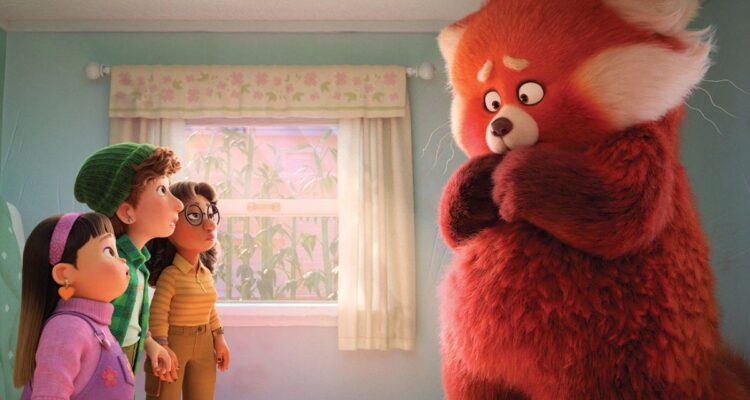Most of the discussion, thus far, around “Turning Red,” Pixar’s 25th (!) animated feature and its first to be solely directed by a female filmmaker, has been around its distribution. “Turning Red,” like last year’s “Luca” and 2020’s “Soul,” will debut exclusively on direct-to-consumer streaming platform Disney+, forgoing a traditional theatrical release. Yes, it is obnoxious that, yet again, the latest Pixar marvel won’t be enjoyed on a mountainous screen. But “Luca” was the most-streamed movie of last year and “Soul” took home the Oscar for Best Animated Feature. What Pixar has lost in a more traditional distribution model, it has made up for in instantaneous, zeitgeist-capturing relevancy. The Internet can talk and debate endlessly about the “Turning Red” release strategy. None of it changes just how good this movie is, which is, in fact, one of the most unique and unforgettable movies in Pixar’s grand pantheon.
The concept behind “Turning Red” premise is as inventive and zippy as anything in their catalog and, coming from the studio that has made animated classics about silent robots and an old man in a flying house, that says a lot. Mei (Rosalie Chiang) is a 13-year-old Chinese girl living in Toronto right after the turn of the millennium. She’s full of self-confidence and gumption – she goes to school where she excels, then comes home to the temple her family runs and tries to make her exacting mother, Ming (Sandra Oh), happy. Also, she has a group of girlfriends (what would be referred to in contemporary culture as a squad), and together they obsess over their favorite boy band, 4*Town. (4*Town’s ultra-catchy songs were created by Billie Eilish and her brother Finneas and the intentionally syrupy score was composed by Ludwig Göransson.) So, you know, the usual.
READ MORE: The 100 Most Anticipated Films Of 2022
Except that, one day, Mei gets super stressed out by her mother and – poof! – transforms into a mystical giant panda. (The fact that this happens and her mother believes Mei to be reeling from her first period underlines the movie’s themes about the awkwardness of puberty and is overall very, very funny.) As it turns out, Mei is suffering from an affliction (you hate to use the word curse) passed down to her from an ancient ancestor, who, in one of the movie’s cooler sequences, summoned the spirit of the red panda to thwart her enemies, protect her family, and (it is implied) kill many men.
Faced with this new inconvenience, Mei has to figure out how to stay calm enough to make it through school, rework the tricky relationship she has with her mother, and, of course, make it to the 4*Town show that is happening in Toronto before the mystical ceremony to reverse the spell is scheduled to happen.
The set-up for “Turning Red” is dynamite. And it’s as cute as you are probably imagining. The animation style has a kawaii-indebted aesthetic; characters are not bound by their physical limitations and often mutate into starry-eyed puppies at the sight of a cute boy, the lighting dramatically changing around them. We saw a loosening of the Pixar “house style” with “Luca,” which drew inspiration from early Hayao Miyazaki cartoons and the stop-motion animation of British studio Aardman, but “Turning Red” pushes things even further. Co-writer/director Domee Shi has described the aesthetic as “Asian tween fever dream,” and that’s about right. Everything is heightened, exaggerated, pushed in ways that earlier Pixar productions would have no doubt deemed uncomfortable but here seems downright magical. Aesthetically, the early 2000s was a goddamn nightmare but somehow “Turning Red” makes you nostalgic for the period – puffy stickers, Tamagotchis, and the shellacked and lacquered hair of boy bands are, yes, still terrible, but the movie makes you miss them all the same.
And while “Turning Red” is fun (in all caps, sent on an early 2000s Nokia phone), there is an emotional element that makes it really stand out. The heart of the movie is the relationship between Mei and Ming; the misunderstanding that they share is heightened after Mei’s transformation since it is yet another part of herself that she has to hide. (Yes, this is something of an inverse of an earlier Pixar favorite, “Brave.”) Domee Shi directed the earlier Pixar short “Bao,” wherein an overprotective mother consumes her bao bun child rather than allow him to leave the house. The exploration of that dynamic is explored further here and is clearly something that she is dealing with and still trying to understand. It’s this specificity, not just culturally but geographically and biologically, that makes “Turning Red” so powerful and lands so hard.
Shi has made a movie about a character whose body is out of control and whose transformation to adulthood has some additional quirks, but no matter how magical things get, it’s still so relatable. We all feel like gross hairy monsters at that age. And rightfully so – we are. What “Turning Red” argues is that if we learn to love and accept that hairy sweaty monster part of ourselves, it’ll probably leave us happier, better adjusted, and with healthier relationships with our friends and family. Also, it might get us to that boy band concert we’ve been dying to attend.
“Turning Red” is unlike any Pixar film before it and yet totally of a piece with their earlier output, full of gorgeous animation and moments that will make you choke back sobs (particularly in the third act, which has thus far been shrouded in mystery and you aren’t going to hear anything about it here), but one that is more keenly attuned to the emotional wavelength of its lead protagonist. It’s messier, hornier, and more frantic. And like the big red panda version of Mei, it’s more lovable because of its faults. [A]
“Turning Red” arrives on Disney+ on March 11.

